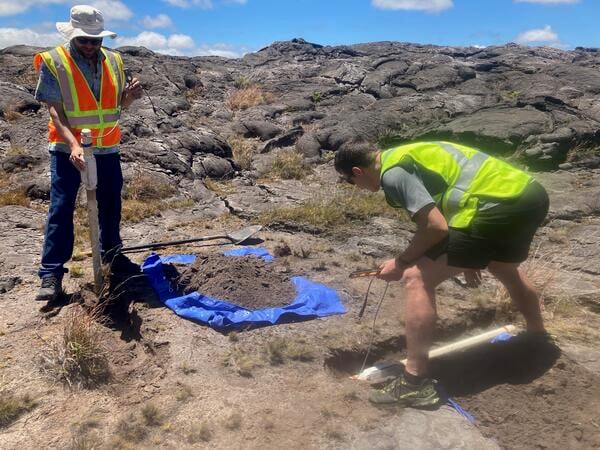Editor's note: Volcano Watch is a weekly article and activity update written by U.S. Geological Survey Hawaiian Volcano Observatory scientists and affiliates. This year is the final year of Kīlauea volcano projects funded by the Additional Supplemental Appropriations for Disaster Relief Act of 2019. This “Volcano Watch” article is about a deep study of subsurface conductivity beneath Kīlauea volcano that will reveal its subsurface magmatic plumbing. The project started within Hawaiʻi Volcanoes National Park last summer and will be completed over the entire volcano this year.
Last year, the team was successful in getting high-quality data at about 40 sites within Hawaiʻi Volcanoes National Park. This year, the team of geophysicists from the USGS Denver office will return in February to collect data at another 65 sites in the Puna District along Kīlauea’s East Rift Zone. The final phase of the work will occur in May-June when the Denver crew will collect any remaining sites both inside and outside of the National Park.
The MT sounding method relies upon natural electromagnetic energy from a combination of solar winds (continuous flow of charged particles from the Sun) interacting with the Earth’s magnetic field and global lighting strikes. Electromagnetic energy with periods (inverse of frequency) between 1 millisecond (1000 cycles per second) to 4,000 seconds (21.6 cycles per day) are recorded at each site. The longer-period data provides a measure of electrical conductivity at greater depths beneath the ground surface.
Why measure electrical conductivity?
Subsurface magma, as well as the surrounding hydrothermal systems, conducts electricity very well whereas cooled and solidified lava flows don’t. The dense network of MT sites on Kīlauea will collect data that we’ll use to map the subsurface locations of magma in three dimensions. Areas of high conductivity beneath the surface will show us where magma is located beneath Kīlauea volcano including the summit magma reservoir and the pathways from there to Kīlauea’s East and Southwest Rift Zones.
The field work will involve setting up sensors to measure the Earth’s magnetic and electric fields at each site. To get information from the greatest depths, data must be acquired continuously for 1-5 days.
A 2002 MT study of the summit and upper East Rift Zone of Kīlauea volcano showed subsurface conductors in three distinct areas within 3 km (2 mi) of the surface. One was beneath Kīlauea caldera, a second was 1.5 km (1 mi) south of the caldera, and a third was beneath and to the south of Puʻuʻōʻō on the middle East Rift Zone.
The conductive zones south of the summit and Puʻuʻōʻō were within fault zones that may have held electrically conductive saline or hydrothermal fluids. The conductive bodies below the summit and Puʻuʻōʻō likely represent the magma conduit from the summit reservoir to the East Rift Zone that fed the ongoing eruption in 2002.
The 2022-2023 MT project will cover almost the entire surface of Kīlauea volcano and allow us to see more detail about the subsurface plumbing of the Southwest Rift Zone and the lower East Rift Zone that fed the 2018 Puna eruption. These data, combined with the data from an airborne electromagnetic and magnetic survey flown last year should give us a very detailed ‘CAT scan’ of the volcano. We hope that the subsurface plumbing that fed the 2018 Puna eruption will be mapped in detail.
Over February, and May-June this year, you might see USGS scientists installing these MT sites across Kīlauea volcano. We appreciate Hawai‘i Volcanoes National Park, Kamehameha Schools/Bishop Estate, the State of Hawaii Department of Land and Natural Resources, the Office of Hawaiian Affairs, and Kapoho Land and Development Company, and various other land owners who have granted us permission to access these locations. More details and updates on the progress of the Kīlauea subsurface conductivity project can be found here https://www.usgs.gov/supplemental-appropriations-for-disaster-recovery-activities/science/2019-kilauea-disaster.


 Support Essential Coverage of Essential Places
Support Essential Coverage of Essential Places



